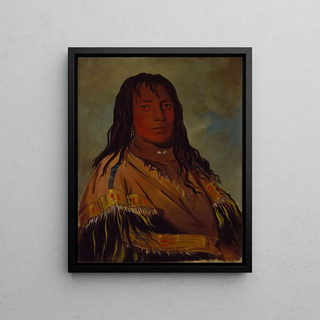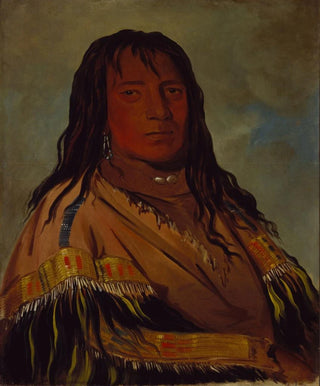Art print | Ch-Tee-Wah-Ne-Che No Heart Chef of the Wah-Ne-Watch-To-Nee-Nah group - George Catlin


View from behind

Frame (optional)
George Catlin’s captivating introduction to the work "Ch-Tee-Wah-Ne-Che No Heart Chef du groupe Wah-Ne-Watch-To-Nee-Nah" offers a fascinating window into a often little-known world. This art print, which captures the essence of an Indigenous chief, evokes not only the beauty of native traditions but also the depth of human emotions. As an artist and ethnographer, Catlin masterfully transcribes a vibrant and complex reality onto canvas, bearing witness to an era when cultures intersected and observed each other with curiosity. Owning an art print of this piece allows you to relive this encounter between art and history, while paying homage to a rich cultural heritage.
Style and uniqueness of the work
The uniqueness of this art print lies in Catlin’s distinctive style, blending realism and romanticism. Every brushstroke appears charged with intention, telling a story that unfolds through the details. The chief’s face, imbued with dignity and wisdom, is highlighted by vibrant colors reminiscent of earth and sky. The traditional clothing, adorned with symbolic motifs, narrates a story beyond the image. Catlin does not merely reproduce; he immortalizes a culture, a moment, an identity. This artistic approach, aimed at capturing the soul of the subjects depicted, makes this art print a true masterpiece—both aesthetic and anthropological.
The artist and his influence
George Catlin, born in 1796, is often regarded as one of the pioneers of Native American painting. His work is marked by an unwavering passion for the peoples he encountered during his travels across the United States. By painting portraits of chiefs and warriors, he not only documented their appearance but also sought to preserve their culture in the face of colonial expansion. Catlin’s influence extends beyond the boundaries of art; it enhances understanding of Indigenous cultures and raises awareness of their history. His works continue to inspire generations of artists and historians, reminding us of the importance of cultural preservation.

Matte finish

View from behind

Frame (optional)
George Catlin’s captivating introduction to the work "Ch-Tee-Wah-Ne-Che No Heart Chef du groupe Wah-Ne-Watch-To-Nee-Nah" offers a fascinating window into a often little-known world. This art print, which captures the essence of an Indigenous chief, evokes not only the beauty of native traditions but also the depth of human emotions. As an artist and ethnographer, Catlin masterfully transcribes a vibrant and complex reality onto canvas, bearing witness to an era when cultures intersected and observed each other with curiosity. Owning an art print of this piece allows you to relive this encounter between art and history, while paying homage to a rich cultural heritage.
Style and uniqueness of the work
The uniqueness of this art print lies in Catlin’s distinctive style, blending realism and romanticism. Every brushstroke appears charged with intention, telling a story that unfolds through the details. The chief’s face, imbued with dignity and wisdom, is highlighted by vibrant colors reminiscent of earth and sky. The traditional clothing, adorned with symbolic motifs, narrates a story beyond the image. Catlin does not merely reproduce; he immortalizes a culture, a moment, an identity. This artistic approach, aimed at capturing the soul of the subjects depicted, makes this art print a true masterpiece—both aesthetic and anthropological.
The artist and his influence
George Catlin, born in 1796, is often regarded as one of the pioneers of Native American painting. His work is marked by an unwavering passion for the peoples he encountered during his travels across the United States. By painting portraits of chiefs and warriors, he not only documented their appearance but also sought to preserve their culture in the face of colonial expansion. Catlin’s influence extends beyond the boundaries of art; it enhances understanding of Indigenous cultures and raises awareness of their history. His works continue to inspire generations of artists and historians, reminding us of the importance of cultural preservation.






